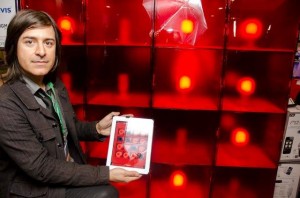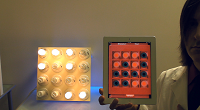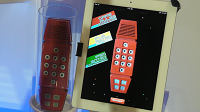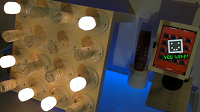 IPv6 Retro-Futurism
IPv6 Retro-Futurism
Contestants: Arman Bastani
Affiliation: Oval Integration
Semi-Finalist
Summary
Our Entry Emulates the past to educate the masses about the future: A large scale display made with IP-enabled light bulbs will be crafted in the motif of the small handheld electronic games that were popular in the late 1980s. We will also create a small, handheld, IP-enabled electronic game based on ‘Lights Out’ that will connect, control, and mirror the game state on the large display version. This IPv6/6LoWPAN Gamification can go beyond the custom hardware since the audience can connect and play with smart phones, tablets, apps, or HTML5 browsers… demonstrating the true power of IP, standardization, and interoperability.
How does your Smart Object/Solution use Internet Technology?
There are 3 parts:
A. The “Retro-Remote” – It is basically a universal, programmable 6LoWPAN remote on steroids. It is targeted to be low cost and a powerful option for users to help add control and intelligence to their IoT ecosystem.
B. The “Large Scale Display” – The next phase is to build a giant version of the remote that is comprised of various Smart Objects itself. Any activity on the Retro-Remote or internet client will be mirrored on the giant version via standard protocols. This will invite and engage people to have a direct experience with the next wave of the Internet.
C. A game system that works together using off-the-shelf parts to form the interactive part of the experience via 6LoWPAN hardware, smartphones, or a standard web browser. This will demonstrate the power of interoperability.
Why did you choose to invent this? What problem does the inventor see that it can solve?
The main drive is to show people the power of building onto ‘the backbone’. We at Oval Integration really believe that there is no better remote control than all the smartphones out there. However, in certain situations it is more convenient and practical to have a dedicated hardware remote. We wanted a remote that can use a scripting language to create custom behaviors, control every aspect from the sound down to led color, and *inexpensively* work using open source and COTS systems. We chose to create one so users have more options for interfacing and controlling their own networks. Adding scripting logic creates a powerful system which we hope to demonstrate via the “IPv6 RetroFuturism” project. This project will hopefully educate and inspire people about the next wave of the Internet, since everything we are using is within the consumers reach. We cannot wait to see what other applications people will dream up!
What is the practical application of your innovation for the everyday user?
We actually use a version of this at our Lab in Southern California. We have remotes sitting by the front and back doors. The buttons can act as ‘mega scenes’ that adapt depending on programmable parameters. For example, there are 2 main categories of scenes, ‘OFFICE’ and ‘WORKSHOP’, that I use depending on why I am going into the lab. When I hit ‘OFFICE’, the remote knows the time of day and fires up the lights by my desk if needed. If I am entering through the back a lighting pathway scene is also triggered. The power amp for our stereo warms up and the remote guesses it is me since I get in at a time different than anyone else. The MP3 server pulls up the last personal playlist that I was listening to while the internet enabled stereo turns on the speaker zone in the office only. The remote contacts another server which in turn sends a ‘magic packet’ that my desktop listens for and then starts booting up, getting ready to hit those spreadsheets! Time is saved every day.
Did you invent new technology? How is your device unique?
It is hard to say if anyone has created an IPv6 retro game out of a smart object network or not. I will have to research that one! The final version, the “RetroRemote”, will be very unique since it will mash up 70s technology with cutting edge internet protocols.
What hurdles did you overcome in creating your device? Were necessary parts easily obtained?
The point of the “RetroFuturism” project is primarily to raise awareness and educate the masses on the next wave of the Internet and connectivity. All of the parts that were chosen are consumer items that can be readily purchased now or in the near future, empowering individuals to create novel solutions on their own. Logistics and Time constraints for this project have been the main issues!
Are there plans to produce your entry for the marketplace, or is it already a product that can be purchased/obtained?
The commercial version of the retro-remote will be the same engine but in a non-70s package. If it goes commercial it would be available from one of our customers that deals in lighting, since Oval mostly does prototyping as a business. If you want to experiment with a similar system you can obtain one from most electronic distributors if you search for NXP’s ‘GreenChip’ or ‘JenNet-IP’ development kits.
Why would you consider your device/solution to be “innovative”?
Inclusion of a lightweight scripting interpreter will bring unprecedented control for remote controls… short of rolling your own custom firmware. Couple that with the advantages of being an inherently IP based object and we will open up possibilities of control that supersedes anything that is out there at the same price.
What would you like to see in the future for the Internet of Things? Why should more companies utilize IP?
I feel like the open protocols are on the right track, but there are many others, open and closed, competing for similar space.. We shall see where the market takes the Internet of Things. Using open standards that are accessible has given Oval Integration, a small company, the ability to stand of the shoulders of giants. Reducing your NRE brings solutions on time and under budget.
For more information visit www.OVALintegration.com or contact Arman Bastani.



